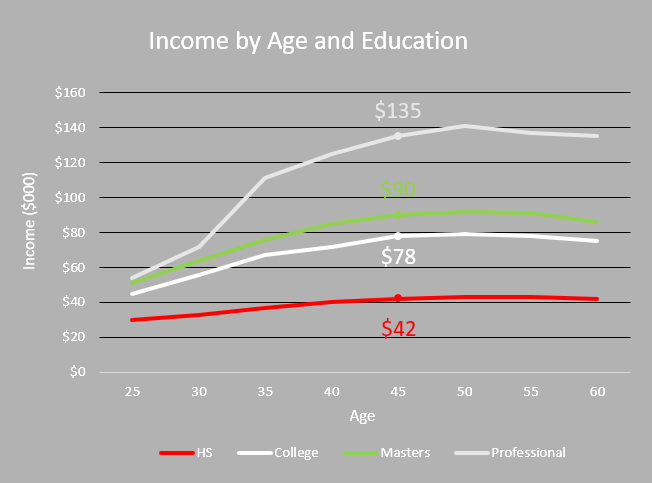A college degree has long been called the surest ticket to the middle class, or beyond. But with changing career paths and high college costs, is a degree still worth the price?
To answer that question, we reviewed the latest financial analyses as well as economic data going back decades. Then we pulled out our pencils and did a bunch of our own math for you – because after all who wants to actually do the math?
We are going to break our answer down into two parts: How much does college really cost and how does a degree impact earnings these days? After that, we will share some thoughts about how to tip the scales in your favor.
The cost.
If your kid is about to head off to a 4-year private college, your estimated cost is about $223,000 according to the ScholarShare 529 College Savings calculator.1 And paying for just ¼ of that with student loans could set you back an additional $18,500 in interest payments.2 Sure, scholarships and financial aid can bring down that cost – sometimes by a lot – but that sticker price is pretty steep.
On the other hand, starting out with 2 years at a community college and then finishing with 2 years at an in-state public school can bring the total price tag down to about $59,000.3 That’s still a lot of money, but way less than a private 4-year school. Here too, scholarships and financial aid can make a difference, plus even a limited amount of savings can help avoid the need for costly student loans.
So, one way to help to make sure college is worth it is to approach choosing a college the same way you would buying a house, a car, or a big-screen TV set. You need to be a savvy consumer in terms of which college you pick and how you pay for it
Ok, that’s the cost… what’s the benefit?
College offers a lot of benefits that are hard to attach a number to. It can shape who you are as a person and provide invaluable experiences. You can make lifelong friends or even meet your spouse… but that is not what we are talking about today, so let’s get back to the numbers.
Here’s some of what we found:
- A college degree still provides a significant income bump. For every $1.00 earned by someone with a high school diploma, on average a college grad will take home $1.68. And that is according to the official government statistics from the Bureau of Labor Statistics for 2022, so those numbers are reliable and up-to-date.4
- That college income bump shows no signs of going away. It has hovered between 61% and 70% for the past 20 years.4
- Over the course of their careers, the average college graduate earns $ 1 million more than someone with just a high school diploma. The average lifetime income for those with a high school diploma averages $1.6 million, versus $2.8 for those was a bachelor’s degree and $4.7 million for those with a professional degree.5
- The average college graduate doesn’t just earn more money, they tend to have more stable careers as well. A college degree or above means you are about half as likely to be unemployed as someone with a high school diploma. This was true not just during the COVID-19 pandemic but consistently for most of the past 20 years as well.6
What about those “high-paying jobs right out of high school” you keep hearing about?
It’s absolutely true there are a lot of great jobs available to kids right out of high school.7 And that path can be really tempting. But over time that story changes, a lot.
By age 45 the average college grad is earning way more than someone with a high school diploma: $78,000 vs $42,000. Those with a master’s degree earn even more – an average of $90,000 a year at age 45.8
That’s because a college degree can not only help your kids get a good first job but also open doors for them for years to come, setting them up on a career path with more upward potential and growth opportunities.

Income differences may not seem like that much when you start out, but they typically grow larger over the course of your career.8
The bottom line and how to tip the scales in your favor.
A good place to start is by listening to the hopes, goals, and ambitions of that burgeoning young adult in your household. Are they dreaming of college or dreading the thought? If they want to pursue a career that not does benefit from a degree, considering alternatives to college may be a worthwhile idea. And the good news is you can use your savings with ScholarShare 529 to help pay for many different higher education experiences, including many trade schools and apprenticeship programs.*
But on average – what the numbers say – is typically a college degree remains a powerful investment in your child’s future. So, shop wisely and choose a college that can give you a good return on the investment. Save as much as you can right now for their education, as that costs a lot less than student loans. And focus on the long-term benefits, because that’s what really counts.
* Withdrawals for registered apprenticeship programs and student loans can be withdrawn free from federal and California income tax. If you are not a California taxpayer, these withdrawals may include recapture of tax deduction, state income tax as well as penalties. You should talk to a qualified professional about how tax provisions affect your circumstances. Read about eligible education expenses.
Apprenticeship programs must be registered and certified with the Secretary of Labor under the National Apprenticeship Act.↩
Sources:
1 Includes tuition, fees, room, and board. Assumes 5% inflation rate for education as of 2/19/23.
2 https://www.bankrate.com/loans/student-loans/student-loan-calculator/). Assumes a $55,697 loan paid over 10 years with a 6% interest rate as of 2/19/23.
3 ScholarShare 529 College Savings calculator. Assumes two years at a 2-year public school at $7,790 followed by 2 years at an in-state 4-year public school at $51,282, totaling $59,072 Both assume a 5% education inflation rate as of 2/19/23.
4 Bureau of Labor Statistics, data series LEU0252917300, LEU0252918500, and LEU0252919100 pulled 2/19/2023. https://data.bls.gov/pdq/SurveyOutputServlet. Based on adults working full time 25-64.
5 The College Payoff. Georgetown Center on Education and the Workforce. Based on 25- to 64-year-olds working full-time. Published 2021. https://cew.georgetown.edu/cew-reports/collegepayoff2021/#data
6 https://www.bls.gov/charts/employment-situation/unemployment-rates-for-persons-25-years-and-older-by-educational-attainment.htm Pulled 2/19/23.
7 https://www.businessinsider.com/high-paying-growing-jobs-that-require-high-school-diploma-2021-9
8 The College Payoff. Georgetown Center on Education and the Workforce. Based on 25- to 64-year-olds working full-time. Published 2021. https://cew.georgetown.edu/cew-reports/collegepayoff2021/#data
FGN-2757451PR-Y0324W









